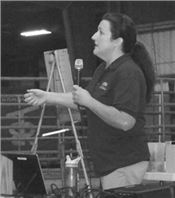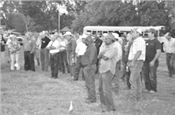|
Cattle Owners Learn To Prepare Winter Pastures, Protect Animal Health At Field Day
ABBEVILLE, LA.
Cattle owners attending the recent Acadiana Cattle Producers Fall Field Day learned about preparing winter pastures, controlling weeds, using mineral supplements and causes of sudden death.
Andrew Granger, LSU AgCenter county agent in Vermilion Parish, talked about planting ryegrass for winter forage at the Oct. 27 event. He showed producers a test plot sprayed with glyphosate and planted with ryegrass using a no-till drill. Another plot was tilled and ryegrass seed was broadcast. Because it hasn’t rain since planting occurred, no ryegrass has emerged. But Granger said the drilled seed will lay dormant in the seed channel.
He said the practices allow an earlier stand to become established with adequate rainfall.
Granger said the glyphosate application in late summer shocks summer perennial plants in a pasture and allows ryegrass a chance to germinate and grow. “It almost mimics a frost,” he said.
But young ryegrass is susceptible to armyworms that thrive in warm fall nights, and he saw an entire stand eliminated by the pest last fall. “I had never seen armyworms that late in the year,” he said.
Stan Dutile, LSU AgCenter county agent in Lafayette Parish, demonstrated cattle handling techniques using a Bud Box, a configuration of gates and chutes, to persuade cattle to move into another pen.
Dutile said low-stress cattle handling techniques help with beef quality.
Claire Sully, of the LSU School of Veterinary Medicine, said the cause of sudden death of an animal should be determined so cattle owners will know if the rest of a herd is threatened by a communicable disease.
She said anaplasmosis, an infectious blood disease spread by ticks, is often a cause of sudden death in Louisiana cattle. She said changing needles between vaccinations is essential to prevent spreading the disease in a herd.
She said vaccinations are cheap compared to the cost of replacing an animal.
Sully said properly fed, well-nourished cattle don’t become sick as often.
Cattle are stressed if they are fed low-quality forage, have little shade, and are subject to parasites and disease. Calves that don’t receive colostrum after birth have a depressed immune system that makes them more susceptible to disease, she said.
Guillermo Scaglia, LSU AgCenter ruminant nutritionist, said cattle may not get adequate trace mineral nutrition so they need to be supplemented. But, he said, excessive amounts of some minerals could be toxic. For example, cattle can suffer from sulphur toxicity from drinking water with high levels of sulfates. A symptom of sulfur toxicity is that cattle have a distinct characteristic of gazing upward, and they are known as stargazers.
Calves who fail to get enough selenium are unable to stand on their own after a few days of their birth, a condition known as white muscle disease; the problem can be solved if detected early with a selenium injection.
Mature lactating cows can become deficient in magnesium if they graze on well fertilized annual ryegrass, he said, with no outward signs of anything wrong for four to eight hours before death. The problem can be solved if a high magnesium mineral mix is provided two to three weeks before they start grazing ryegrass and throughout the grazing period, he said.
Scaglia said cattle can be given mineral supplements through injections or mixing the mineral mix with salt. But cattle owners should avoid putting out salt separate from mineral supplements because cattle will naturally be drawn only to the salt.
He also said yellow sulphur blocks are not needed by a herd if a complete mineral mix is provided.
Cattle producers also viewed test plots to show weed control on the Clyde Prejean farm, and Blair Hebert, LSU AgCenter county agent in Iberia Parish, demonstrated mixing and handling techniques for pesticides. ∆

Claire Sully, of the LSU School of Veterinary Medicine, talks at the
Acadiana Cattle Producers Fall Field Day about possible causes of sudden death in cattle.

Cattle producers listen as Andrew Granger, LSU AgCenter county agent in Vermilion Parish, talks at the Acadiana Cattle Producers Fall Field Day
about different ways of preparing winter pastures.
Photos by Bruce Schultz
|
|